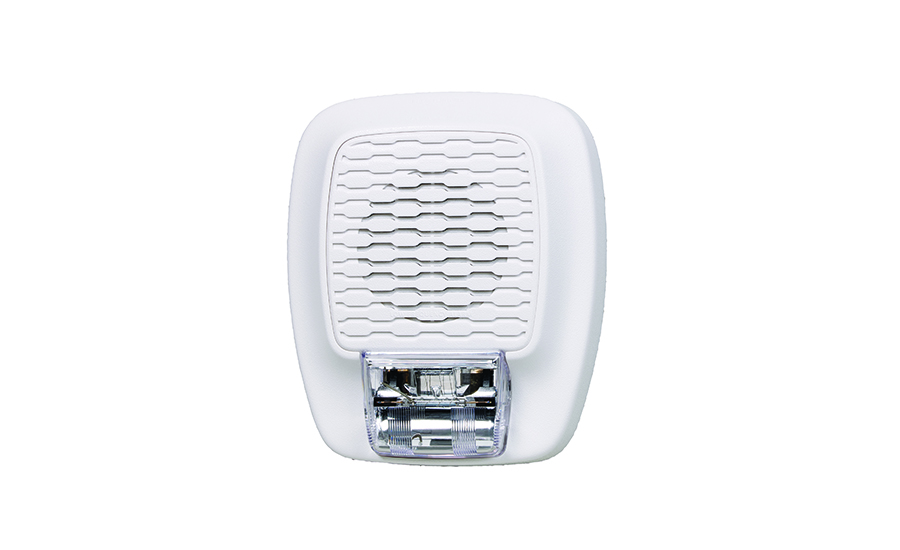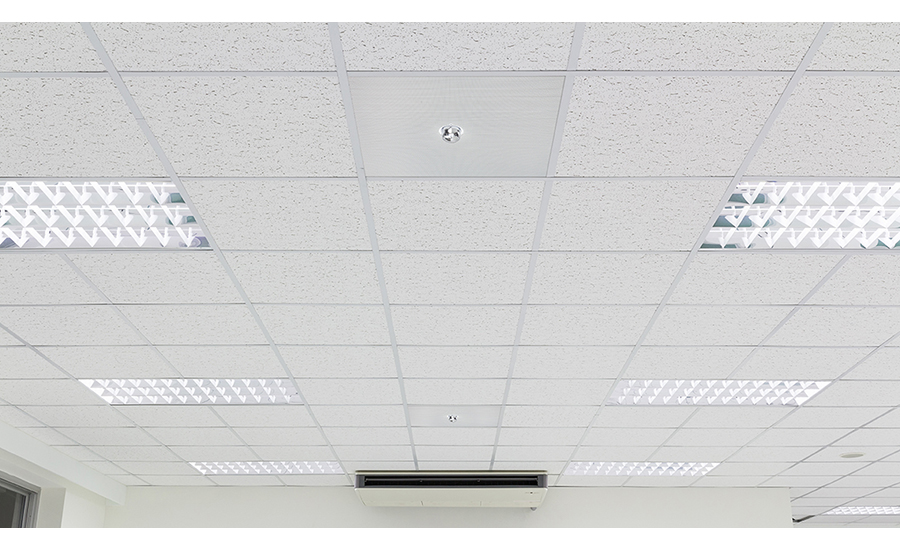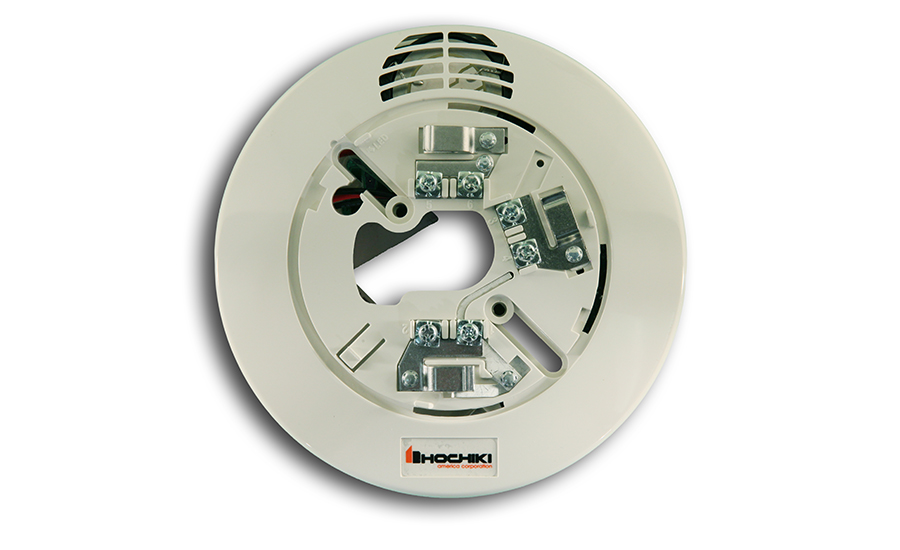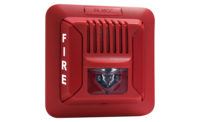The sound of a fire alarm going off can elicit different feelings, depending on who you talk to. The dedicated office worker might perceive the strobes and noise as a distraction from writing a business report, interrupting the focus they had just achieved. A rascally young student bored in class might consider the beeping as a sign from above.
But, to those working in the fire and life safety industry, the sound and strobes of a fire alarm is more than a trek out of the office or an outdoor reprieve from class. “In the two years since the COVID-19 pandemic, our relationship with commercial buildings has changed,” says Chris Hill, global product manager, notification, Edwards/Kidde Systems, Bradenton, Fla. “Now, occupants are much more spread out throughout buildings and campuses, making it more important for buildings to increase the visual and audible coverage of the building.”
These devices are so important that they often need protecting, with manufacturers making polycarbonate covers for the devices.
“Because of applications in gymnasiums against balls hitting the strobes, or against them getting damaged or broken in general applications, we started making polycarbonate covers to protect them,” says Michael Mikaelian, vice president of sales, STI, Waterford, Mich.

Gentex’s GHLF is low-profile, features a low audio frequency and is listed for use with fire protective systems by UL. // IMAGE COURTESY OF GENTEX
Fire alarm signaling devices — including strobes, horns and sounders — have made major advances that increase building safety and improve the longevity of the device. And code changes have reflected that trend.
“You know, just 20 or so years ago the chapter on notification appliances was only a couple of pages,” says Bill Denney, technical project manager, Hochiki America Corporation, Buena Park, Calif.
Alphabet Soup: Code History
The latest edition of NFPA 72, the National Fire Protection Association (NFPA) guidelines on fire alarm and signaling systems, was released in 2022. The code tells an installer how systems should be installed inspected, tested, and maintained. Model codes, such as NFPA 1 or NFPA 101 — also known as the International Fire Code — indicate when a fire alarm or signaling system is to be installed for different types of buildings.
“For example, these codes require voice evacuation systems that use speakers instead of horns to notify building occupants in certain buildings such as K-12 schools with an occupant load greater than 100, high-rise buildings, and assembly occupancies with an occupant load greater than 1,000 or more,” says Richard Roberts, senior industry affairs manager, Honeywell, Atlanta. “The 2021 edition of the IFC (International Fire Code) now requires smoke alarms installed in a hotel guest room or a bedroom of an apartment building dwelling unit to produce a low frequency audible alarm signal to help awaken people sleeping. If the smoke alarm does not produce the low frequency signal, then a smoke detector with a low frequency sounder base must be installed.”
Roberts adds, “Requirements relating to low frequency, mass notification and carbon monoxide detection continue to expand with each new edition of the model codes and NFPA 72.”
The requirements for notification appliances can be found in chapter 18 of NFPA 72, with the code being updated every three years. In fact, the 2025 NFPA is already in the beginning stages of creation.
“More recently, during the past two decades the standard has grown to incorporate stricter performance targets and account for technology advancements,” says Patrick Sestier, senior engineer, Mircom, Vaughan, Ontario. With this said, it’s important to be as updated as possible to ensure building occupant safety.
“Notification appliances installed before the year 2000 may not be compliant to the code today,” Hill says.
Codes can also change based on new laws. Take the passage of the Americans with Disabilities Act (ADA) in 1990, which made strobes a requirement for deaf and hard-of-hearing individuals. “In 1999, the NFPA updated the strobe requirements to include synchronization to prevent epileptic episodes for people with photo sensitivity,” Hill says. “Today, strobes are required to be synchronized within 10 milliseconds, and the pulse width of the light output needs to be 20 milliseconds or less. The strobes must be listed for use with compliant fire alarm panels to ensure the synchronization is correct.”
Much like the rest of the security industry, cybersecurity is a new concern for the fire alarm industry. The 2022 NFPA 72 includes a new section on cybersecurity measures, found in chapter 11 and Annex J.
“There’s been a lot of documented attacks where some people were able to get into the fire alarm system,” says Shawn Mahoney, technical services engineer, NFPA, Quincy, Mass. “They were able to use that to get into other building systems, and then cause harm to other systems.”

Fire alarm signaling devices are now discreet and stylish, thanks to advances in the technology, including LED lights in strobes. // IMAGE COURTESY OF HONEYWELL
The latest version of UL 864, the standard by Underwriters Laboratory (UL) for control units and accessories for fire alarm systems, was released in 2020, which allows for greater flexibility and options of system configuration.
“So an input circuit, for example, at one time could only just initiate an alarm,” explains Allan Sanedrin, principal engineer, fire and life safety signaling systems, UL, Northbrook, Ill. “Now that input circuit can be programmed to initiate other events, or drive different features and behaviors of the system. So 864 has been updated accordingly to match and keep up with technology.”
Although most buildings may be following the guidelines in the 2019 edition of NFPA 72, it’s important to work closely with your local Authority having Jurisdiction (AHJ) to see which version of NFPA to use. This is determined at the state, local and municipal level.
Denney adds, “The standards organizations are always working to improve and fine-tune the codes to make them more effective for life safety, while considering the many situations in which fire alarm and life safety systems are utilized.”
Low Frequency Alarms on the Rise
How do you alert those who are deaf or hard of hearing that there’s a fire while they’re sleeping? Or really, anyone who is sleeping? That conundrum was solved in the 2019 NFPA 72 with the addition of a 520Hz low frequency tone required for sleeping rooms, found in chapter 18.4.6.3.
“The research has found that the lower frequency sounds have a better sleep waking effectiveness for people who are hard of hearing, people in general, and those with any disabilities” Mahoney says.
With applications in dormitories, hospitals, nursing homes, hotels, and more, security professionals are noticing the rise of low frequency alarms.“We’ve seen the fastest growth in that particular segment of the signal market,” says Dave Christian, director of sales, Gentex, Zeeland, Mich.

Sounder bases are used with digital analog sensors. This one from Hochiki is typically used in hotels, apartments, and hospitals. // IMAGE COURTESY OF HOCHIKI
Indoor Sounds
The most common notification appliances are horns, strobes, and horn-strobes, as well as speakers and speaker-strobes. However, voice systems that use pre-recorded and live voice messages seem to be on the rise.
“Of course, it is required for some applications, but even smaller systems benefit from this,” Denney says. “People generally respond better to a voice announcement than the sound of a horn or bell.”
In fact, schools with more than 100 occupants now require voice evacuation by codes including NFPA 101 (Chapter 14.3.4.3.1.2).
Denney adds, “These address the quality of the voice system, moving beyond traditional requirements around audible decibel output to ensure the intelligibility of the speaker. The Speech Transmission Index (STI) measures how intelligible spoken words are over an audio application, and we have seen many advancements that improve the clarity of these audio messages.”
And, voice systems can be incorporated into other applications that promote building safety, like telling inhabitants of an intruder or weather event.
“The voice system provides you more recall specificity of what the event is,” says John Holba, portfolio leader for building communication products, Honeywell Building Technologies, Atlanta. “So it’s not just a fire alarm signal. You could use it for emergency communication.”
A Brighter, Longer Future
Like headlights in newer car models, LEDs have made their way into signaling devices.
“Because they’re so much brighter and power efficient, they last a lot longer,” says Rodger Reiswig, fellow and vice president of industry relations, Johnson Controls, Milwaukee. “They pick up a smaller footprint, so it’s not this big giant device on the wall anymore. We have devices as big as a cell phone now. They are more aesthetically pleasing to the architects.”
LED technology in visual notification devices is a benefit when it comes to voltage drop on long circuits and load on multi-appliance circuits.
“Due to the synchronization requirements, many notification appliances have an issue with efficiency and power consumption,” Hill says. “Strobes with LED technology and new electronic designs can reduce current draw for the systems.”
Hill points to Edwards/Kidde’s product line, where the current draw for Genesis LED products is the same across all candela settings, allowing those settings to change without affecting the power calculations or wiring.
| Light pulse duration (msec) | Device rating required effective candela multiplier | Light pulse duration (msec) | Device rating required effective candela multiplier |
|---|---|---|---|
| 20 | 1.00 | 115 | 4.02 |
| 25 | 1.22 | 120 | 4.13 |
| 30 | 1.43 | 125 | 4.23 |
| 35 | 1.64 | 130 | 4.33 |
| 40 | 1.83 | 135 | 4.43 |
| 45 | 2.02 | 140 | 4.53 |
| 50 | 2.20 | 145 | 4.62 |
| 55 | 237 | 150 | 4.71 |
| 60 | 2.54 | 155 | 4.80 |
| 65 | 2.70 | 160 | 4.89 |
| 70 | 2.85 | 165 | 4.97 |
| 75 | 3.00 | 170 | 5.05 |
| 80 | 3.14 | 175 | 5.13 |
| 85 | 3.28 | 180 | 5.21 |
| 90 | 3.41 | 185 | 5.29 |
| 95 | 3.54 | 190 | 5.36 |
| 100 | 3.67 | 195 | 5.43 |
| 105 | 3.79 | 200 | 5.50 |
| 110 | 3.90 |
“LED-based strobes are much more prevalent these days, leading to more reliability and lower power requirements,” says James Catt, product specialist, Viking Electronics, Hudson, Wis. “Additionally, IP-based paging for notifications allows a broader coverage area with more flexibility for different zones.”
Light strobe pulse is also important, according to Christian of Gentex.
“There was a recent [NFPA] study that showed it was very important to have a specific pulse width or pulse duration of the light pulse,” he says. “And that caused a change both to the NFPA code and also the lifting standard. So it used to be originally you could go down to a pulse width of 200 milliseconds. Now, after a number of studies and a lot of research, it has been brought all the way down to 20 milliseconds.”
The Future of Fire Alarm Signaling Devices
According to those interviewed, the advances and integrations in fire alarm signaling devices speaks toward an overall trend of healthy buildings and holistic security systems.
“Your fire alarm system is monitoring your sprinkler system; it’s connected to your elevator system controlling your elevator for elevator recall; it’s closing fire doors; it’s controlling your HVAC systems,” Mahoney says. “There’s a lot of integration in your fire alarm system, so it essentially becomes the center point of your fire and life safety [system]. If there’s ever an issue with your fire alarm system, or things aren’t programmed correctly or connected correctly, then there goes your whole fire and life safety strategy.”
Mahoney notes that there has been a push in past editions of the life safety codes and building codes to require integrated fire protection or life safety system testing, where required fire alarm testing becomes less isolated and is instead connected to requirements in sprinkler and elevator testing — for example, making sure the fire alarm system can recall an elevator or is checking that the alarm is getting the correct signals from the sprinkler system when water flows.
“If we’re not making sure that they stay integrated or they’re tested properly, it could be just as big of an issue,” he adds.
Horns might not even be implemented or necessary, judging by trends in voice technology and implementation.
“Horns are going to be a thing of the past,” Reiswig says. “Everybody’s turning to voice technology.”
Regardless, the possibilities in the future of fire alarm signaling devices are endless.
“Who knows what the future holds, with the Internet of Things (IoT) making inroads into so many areas of life,” says Denney of Hochiki. “It is an exciting time to be involved in the fire industry.”




